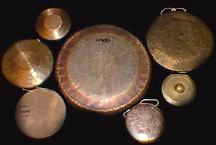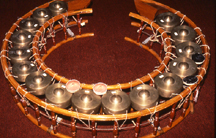| Other
Instruments
|
| GALLERY
| 

|
Gongs
Gongs of various sizes and design
are used all over Southeast Asia. A Western term for
large gongs is "tam-tam." Most gongs are
usually hanging from a frame and struck with a padded
beater but some are played horizontally on a frame
and are struck with harder mallets. The gongs pictured
here are all hanging gongs either from a frame by
a cord or from the tips of the fingers. The large
gong in the center is a tam-tam made in Europe by
Paiste. On the upper left is a Chinese xiao-luo
used in Beijing opera (also known as Peking opera
or jingxi but there are many regional styles/names
in China & Taiwan), which is hand held and struck
with a flat wooden stick causing the pitch to bend
up (this gong is known in the West as an "opera
gong"). Just below that is a Chinese da-luo
(also used in Beijing opera), which is suspended from
a cord and struck with a flat wooden stick causing
the pitch to bend down (this gong is also known in
the West as an "opera gong"). On the bottom
left is a flat metal plate known as a temple gong
(or bell plate) made by the Italian company UFIP.
On the upper right is a medium-sized hand-hammered
gong from China. Below that is a Filipino "nipple
gong" from a kulintang, which is a set
of many such gongs all pitched differently. The raised
center tunes the gong to a single pitch so that melodies
can be played on sets of these types of gongs. Horizontally-played
gongs with a raised centers like these are arranged
on racks and used in the traditional musics of Thailand,
Burma, Cambodia, Indonesia, Malaysia, and Brunei.
On the bottom right is a hand-hammered South Korean
gong known as kkwaenggwari, which is held
from the finger tips and struck with a wooden mallet.
This type of gong is used in Korean musics known as
sangsoe/nongak, samulnori,
and pungmulnori. The gong circle is a Thai
khong wong yai (see entry for more). |
|
| |
|
|
© & ℗1999-N. Scott Robinson/New World View Music-BMI. All rights reserved.
NOTE: I no longer use any social media beyond this website & YouTube
N. Scott Robinson - sonrob@msn.com
|

